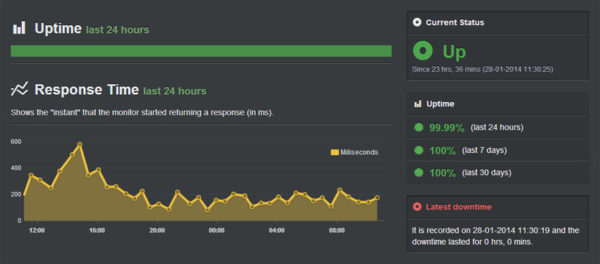What You Need to Know About Uptime Monitoring
Most people who go online today expect web resources to load in less than 2 seconds. Customers who are not satisfied with website speeds are unlikely to follow surveys, register, or make purchases. That is how weighty the subject of Web platform performance has become.
Uptime is the key player in this game. Hosting uptime is the amount of time that websites are up and running and, therefore, available to potential clients and visitors. Higher percentages of this parameter may increase traffic to a site, leading to a boost in SEO and possible conversions.
The opposite of uptime is called downtime. People cannot reach a site when it is down. It is highly unlikely that people can visit a site that they were not able to reach the first time.This could frustrate potential visitors, reduce traffic, and lead to substantial online revenue losses.
Importance Of Uptime Monitoring
Organizations are responsible for monitoring their own services and website uptimes. This ensures that they have a clear view of their hosting provider’s performance. More importantly, it makes it possible for them to be the first ones to know when their sites go down. This way, they can respond quickly.
Of course, hosting providers do monitor uptime, but organizations should never leave all the work in other people’s hands. Co-monitoring with web hosts helps a company to confirm if the providers are keeping their promises. It also gives the organization the ability to control their site’s performance to some level.
How To Track Website Uptime
Organizations do not have to check their websites’ performance now and then on browsers. Instead, they can simply find network uptime monitors. These special web tools auto-check site uptimes and give alerts of any deviations from the normal performance.
Types Of Uptime Monitors
Dozens of server monitoring tools are available online. Depending on the complexity of the functions they perform, some of them are free while others cost some good money. For instance, some may only check whether a site is running. Others can run at least 50 checks simultaneously.
There are four types of uptime monitors. They include:
1. Ping Monitors
These types simply query websites to confirm whether they are up and running. Think of them as virtual ping pong balls. Serving a ball to a wall makes it bounce back. The ball cannot connect to the wall that is down. Ping monitors sense missing connections when sites are down and notify network managers.
These monitors also provide insight into downtime statistics and Internet connection speeds. Especially, connection speeds are very important. Visitors do not like slow websites. Slow speeds also reduce Google search rankings. Ping monitors enable managers to respond to such important information quickly.
2. HTTP Monitors
People use HTTP to transfer data online. They use set rules that instruct servers and browsers on which information to exchange. HTTP monitors participate in this exchange. This makes it possible for them to provide information about the traffic between computers and the Internet.
3. DNS Server Monitors
Computers respond with numerical addresses. DNS protocols translate online addresses into their corresponding numerical addresses. DNS server monitors work in line with this principle. They match information and run behind the scenes checks of addresses.
DNS server monitors can provide detailed information about uptime, network outages, protocol failures, among other things. More importantly, the monitor’s sense and report mismatches between numerical addresses and their corresponding online addresses. Such mismatches could be a result of hacking.
4. TCP Port monitors
Transmission Control Protocols transfer data between network devices using retransmission strategies. The strategies ensure that no data losses occur during each transmission. The quality monitoring and the established host-to-host communications make it possible to detect and report connection problems quickly.
Choosing An Uptime Monitor
Every organization has different needs. The choice of an uptime monitor depends on an organization’s network requirements. Before settling on any tool, network managers must consider the following key factors:
- The most preferred time interval between each check.
- How alert messages should be sent out?
- The reporting option that the system provides.
- The cost of the monitoring tool.
However, medium and big businesses should never live with assumptions. For such, server and web page monitoring is not enough. Also, they should monitor login pages, hosting servers, hardware components, and vital applications. To do this, they need to get monitors that serve all these purposes.
Not Sure Which Monitor To Choose?
Sometimes, an organization may not be sure which uptime monitoring tool to choose. In such a case, testing a provider’s free trial version of the tool could help in making a solid decision. If satisfied with the trial, why not settle with it and pay for the full version?
How About The Company?
Apart from the quality of monitoring tools, hosting providers promise minimum uptime percentage guarantees. It means they would ensure that users’ sites run at that percentage 24/7. The general rule is that no one should work with hosts who provide guarantees of less than 99.9%.
What TO Do When A Site IS Down
Sometimes, unfortunate things happen even when organizations have applied enough defense measures to their networks. Some things could cause websites to go down. Is this a time to troubleshoot? Maybe. Nonetheless, here are some things that one should immediately do in such a case.
- Use different services to double check the site’s uptime. Are My Sites Up, Is Up, and Down For Everyone or Just Me are some important free web apps that one could use.
- Alert the web host concerning the matter. If the monitoring service has given reports, the user should send them to the provider. Users should never assume that their web hosts are aware of the situation.
- Wait for the web host to respond. There’s nothing much that the organization can do about the situation if the provider is responsible for the outage. This is why it is important to choose reliable web hosts.
- If the problem persists and the web host does not respond properly, it is advisable to switch to another provider.
Bottom Line
With the constant cyber threats that rage the world today, no sites can be successful without uptime monitoring. It is important to work with hosts that monitor uptimes carefully and apply powerful defenses proactively. Also, organizations must do their own monitoring as a secondary measure.


















